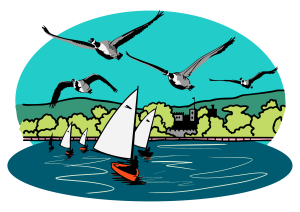Play Audio Story
Audio clip 3 available here on audio player.

As Steward of the Dues, Tim Faulkner is proud of his title and the long history that has accompanied his role all the way back to the Middle Ages. Appointed to this station by the Earl of Devon, and having worked for Powderham Castle since the age of 28, Tim is charged with managing the trade and activity across this section of the river. In his reflections, recorded on the water, Tim describes the quietness and natural beauty of the estuary, and how the river and people enjoy it have changed over the years.
This trail marker is on a fence near the start of the Exe Estuary cycle path with a view across the estuary.
What 3 Words: ///cans.unscathed.openings
Tim: I’m the “Steward of the Dues”, and dues are the money that you levy from, in historic terms, the cargoes and things, and the trade that used to go on the river. These days the Steward – it’s an appointment by the Earl of Devon – so I work for Charlie, and I started working for his father. And basically, the Steward of the Dues, I’ve no idea how many there have been but it goes back to the Middle Ages.
The Exe, I just love it for its wildness. When you come down here on a winter’s day, you might see some bait diggers walking along, the crab tilers, on the front there, you might see the odd person on a boat, but generally, it’s completely empty. That side, you’ll probably have bicycles and dog walkers and stuff all the time. But this side, it’s much quieter. Then putting my business hat on, I’d love to see a stonking great Marina here next to the railway line coming out into the estuary with boat parking and access and car parking on the other side done as tastefully as you can possibly do it but benefiting the estate . I’d love to see that.
If this was Salcombe it would be rammed with boats. The reason the Exe isn’t, is its geography. If you come out of the Exe, it’s quite a difficult channel and it’s quite shallow. So, for boats to be able to navigate – in the old days, there were ships and things coming in here. You couldn’t do it now. Where we’re sitting now, we’re at high water now, there’s probably about 20 feet of water. But when the tide’s out in six hours’ time, we’ll be about three feet off the bottom and we’re pretty much in the channel here. There’s really, there’s no big navigation. We’re not allowed to dredge, so we can’t keep the channel open. And the channel off the Fairway, as they call it, off Exmouth, which is the way out to sea, there are shifting sands there and it gets very, very shallow. Even some small boats won’t be able to get out at all states of the tide.
The other thing that’s absolutely taken off is the rise of the RIB. The RIB, Rigid Inflatable Boat, costs many, many thousands in most cases. There’s one boat that comes to the café I’ve seen, which wouldn’t be out of place in South France. It would probably cost a quarter of a million pounds. It’s a day cruising boat for turning the key, dipping out onto the water, and zooming around, and going for nice lunches. That’s the top end of the RIB market but there’s 500 other RIBs on the river probably that are around about the 200-horsepower mark, maybe 100 to 200 horsepower. You can wakeboard behind them, you can ski behind them, or you can just go for a picnic, or you can just finish work in the evening, walk down to your boat, turn the key, and just go for a nice cruise for an hour up and down the river. That’s what’s changed.
Backward to Marker 2 – The Earl of Devon Forward to Marker 4 – The Boat Builder